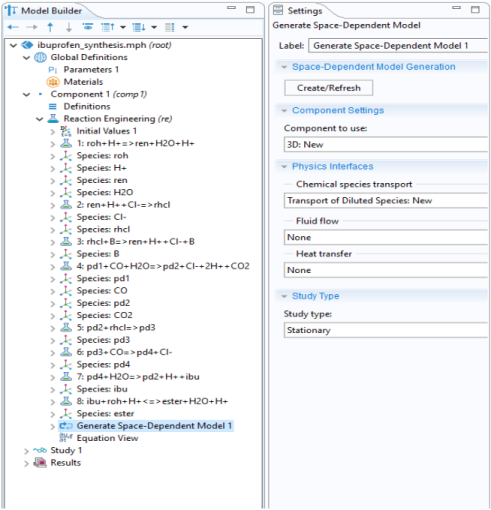It is often relevant to perform an extended analysis of the reaction model. For example, to study how a reacting system’s detailed geometry impacts the concentration and temperature distributions. Use the Generate Space-Dependent Model feature tool to export the properties within the Reaction Engineering interface to other COMSOL Multiphysics interfaces where a space-dependent model is set up. Properties that are exported are reaction kinetics, thermodynamics, and transport parameters.
To add this feature, on the Reaction Engineering toolbar click
Generate Space-Dependent Model (

) or right-click the
Reaction Engineering node to add it from the context menu. Only one
Generate Space-Dependent Model node can be added.
To utilize the Generate Space-Dependent Model feature, make selections in the following order:
Then click the Create/refresh button to create the space-dependent model (
Figure 2-6).

Select a Component to use. Either specify the space dimension of a new component —
1D,
1Daxi,
2D,
2Daxi, and
3D — or select a component already defined in the Model Builder.
Select the applicable physics interfaces to create from the Chemical species transport,
Fluid flow, and
Heat transfer lists. The physics interfaces available are based on the specific modules installed. These include the Chemical Reaction Engineering Module, the MEMS Module, the Heat Transfer Module, and the Subsurface Flow Module. Note that a mass balance physics interface must always be selected when generating a space-dependent model.
The Chemistry Interface is always created and added when generating a space-dependent model. It generates and announces global variables for the reaction kinetics, thermodynamics, and transport properties from the Reaction Engineering interface. The global variables generated are available for all space-dependent interfaces.
Figure 2-7 displays an application where a Reactions feature uses reaction rates defined by a Chemistry interface. The syntax
chem points to the default
Name of the Chemistry node.
If necessary, variables and properties in the Chemistry node can be accessed with the Chemistry node Name (default
Chem). An arbitrary reaction rate expression,
R, is thus written as
comp2.chem.R in the corresponding text fields of the generated interface (see
Figure 2-7).
When surface species are present (that is, when the Species Type is set to
Surface species for at least one species in the reactor), the behavior of surface reactions in the space-dependent model depends on which chemical species transport interface is selected.
A corresponding reaction feature is added and set up, in accordance with the reaction kinetics defined in the Reaction Engineering interface, when clicking the
Create/Refresh button in the
Space-Dependent Model Generation section. In
Figure 2-8, the surface reaction kinetics in a
Reacting Engineering interface has been implemented in a
Packed Bed feature using a
Reactions subfeature. Note that the surface reaction rates are defined by the
Chemistry interface with the
Define variables for porous pellets being checked under
Pellet Chemistry section.
The model generation automatically defines the dependent variables for all species. The Transport of Diluted Species, Transport of Diluted Species in Porous Media, Transport of Diluted Species in Porous Catalysts, Transport of Diluted Species in Packed Beds, and Nernst-Planck Equations interfaces use the default variable names according to the syntax cspeciesname, referring to species concentrations in mole per volume. The Transport of Concentrated Species, Transport of Concentrated Species in Porous Media, Transport of Concentrated Species in Porous Catalysts, and Transport of Concentrated Species in Packed Beds interfaces use the syntax
wspeciesname for default variable names, referring to the species weight fraction. The initial values for the dependent species variables in the space-dependent model, are based on the initial species values collected in the Reaction Engineering interface.
Species density (see Equation 2-93,
Equation 2-94, and
Equation 2-95) and dynamic viscosity can for some mixture options be transferred from the Reaction Engineering interface to the Fluid Flow interfaces.
The densities are available from the Calculate Transport Properties section in the interface, where the fluid mixture properties are selected. The density depends on the
Species settings and is computed as follows for:
The heat capacity, cp (SI unit: J/(mol·kg)), of the mixture is calculated by the species’ molar heat capacity,
Cp (SI unit: J/(mol·kg)) according to
where M is the molar mass (SI unit: kg/mol) and
wi the weight fraction.
The Porous media type is available when
Transport of Diluted Species in Packed Beds or
Transport of Concentrated Species in Packed Beds is selected for
Chemical species transport and the
Heat Transfer in Porous Media is selected for
Heat transfer. There are tree options the
Porous media type:
These options are the same as that for Porous Medium feature under
Heat Transfer in Porous Media interface. The heat balance equation is set up inside pellets when the
Packed bed is selected.
Select a Study Type, either
Stationary or
Time Dependent. It is also possible to edit this choice after the space-dependent model has been generated.